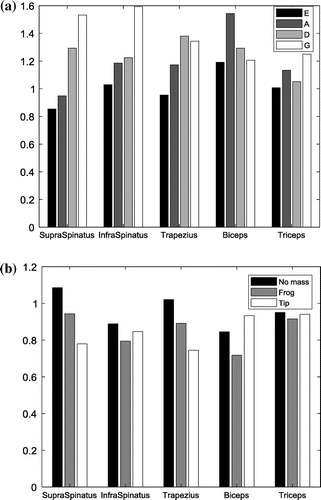1. Introduction
In string musicians, playing-related musculoskeletal disorders are a significant problem (Kaufman-Cohen and Ratzon, Citation2011). However, only a limited number of biomechanical studies investigated the movements of bowed string musicians. According to Kelleher et al. (Citation2013), only 22 biomechanical research studies focused on violinists and 8 focused on the kinematics of the right arm lifting the bow. Electromyography (EMG) has been used to study the muscular activities of string players during trills, vibrato and to assess shoulder rest effect (Visentin and Shan, Citation2011). These studies focused solely on the left arm muscle activity, whereas the muscular activity of the right arm has never been quantified.
The objective of the present pilot study is to provide a first insight of the muscle activity variations of the right arm lifting the bow with respect to the string played, the tempo and bow mass changes.
2. Methods
2.1 Subject preparation
A healthy participant (168 cm; 72 kg; 30 years) with an expert violin level (>10 years of classes) participated in this study, approved by the Ethics Committee of the University of Montreal.
Skin markers were glued on the main upper limb anatomical landmarks. Surface EMG electrodes were set on the following muscles: the supra-spinatus, infra-spinatus, upper trapezius, triceps and biceps.
2.1 Data collection
The participant was asked to play legato at 2 tempi (60 and 90) on the 4 different strings (G, D, A, E) of his own violin using his personal bow. Then, he was instructed to play spiccato on the A string at a tempo of 120 with three bow configurations (a control configuration and two configurations where a 5 g mass was added on the frog or the tip of the bow). Three repetitions were performed for each of these three configurations. Hence, 8 legato trials and 9 spiccato trials were performed for a total of 17 trials.
EMG data were recorded during 5 cycles of bow down and up. The skin markers trajectories were recorded using an optoelectronic system. These trajectories allow the identification of specific moments in the bowing motion cycles.
2.1 Data treatment
The raw EMG signals were filtered using a zero-lag 4th-order Butterworth band-pass filter between 20 and 400 Hz. Then, the Root Mean Squared (RMS) EMG were computed using a 50 ms sliding window (Blache et al, 2016). For each trial and each muscle, the mean muscular activity was calculated by averaging the RMS EMG and normalizing this value using the average over the 17 trials.
Finally, the standard deviations, averages and variation coefficients (i.e., standard deviation divided by the average) of the mean muscular activity were calculated over the three repeated trials. The influence of the string played, the tempo and the added mass was assessed by comparison to the mean muscular activities.
3. Results and discussion
Dispersion - The variation coefficients were below 0.1, meaning that mean muscular activities deviated less than 10% from their averages over the repetitions. This result highlights the fair inter-trial repeatability of the EMG measurements.
Influence of the string played – The mean muscular activities were higher for lower strings (Figure (a)). The higher activity of the shoulder muscles (infra-spinatus, supra-spinatus, upper trapezius) when playing lower strings can be explained by the functional role of these muscles in arm elevation. This finding is in agreement with the results from Visentin and Shan (Citation2003) who found higher articular loads at the shoulder for lower strings.
Figure 2 Mean muscular activities. (a) Legato at 90 over the 4 strings. (b) Spicato with three configurations of mass on the bow

Influence of the tempo – The mean muscular activities were 18% higher (on average) for a higher tempo. This funding is in agreement with the conclusion from Berque and Gray (Citation2002) who noticed that more upper trapezius activity was required for playing a difficult piece.
Influence of the bow mass – The mean muscular activities of the shoulder muscles were lower with mass addition (Figure (b)). This may be explained by two reasons. (1) The added mass may affect the inertial parameters resulting in a more balanced bow, which required less muscular efforts to be stabilized. (2) The position of the bow centre of gravity may have shifted inducing another posture and thus different muscular efforts of the participant in order to manage playing spiccato. In any case, this result shows that addition of mass as small as 5 g can produce measurable muscular activity variations.
4. Conclusions
This pilot study suggests that muscular activity of the bowing arm of the violinist is influenced by the string played, the tempo and the mass distribution of the bow. These results will have to be confirmed by testing a larger panel of participants. These first results are encouraging for further investigations on the impact of the bow, since 5 g mass variations happen to have an impact on mean muscular activity of the shoulder muscles.
References
- Berque P, Gray H. 2002. The influence of neck-shoulder pain on trapezius muscle activity among professional violin and viola players: an electromyographic study. Med Probl Perform Art. 17(2):68–76.
- Blache Y, Dal Maso F, Desmoulins L, Plamondon A, Begon M. 2015. Superficial shoulder muscle co-activations during lifting tasks: Influence of lifting height, weight and phase. J Electromyogr Kinesiol. 25(2):355–62.
- Kaufman-Cohen Y, Ratzon NZ. 2011. Correlation between risk factors and musculoskeletal disorders among classical musicians. Occup Med (Lond). 61, 90–95.
- Kelleher L, Campbell K, Dickey J. 2013. Biomechanical Research on Bowed String Musicians: A Scoping Study. Med Probl Perform Art. 28:212–218.
- Visentin P, Shan G. 2003. The kinetic characteristics of the bow arm during violin performance: an examination of internal loads as a function of tempo. Med Probl Perform Art. 18(3):91–8.
- Visentin P, Shan G. 2011. Applications of Emg Pertaining to Music Performance - a Review. Arts BioMechanics. 1(1):15–32.

